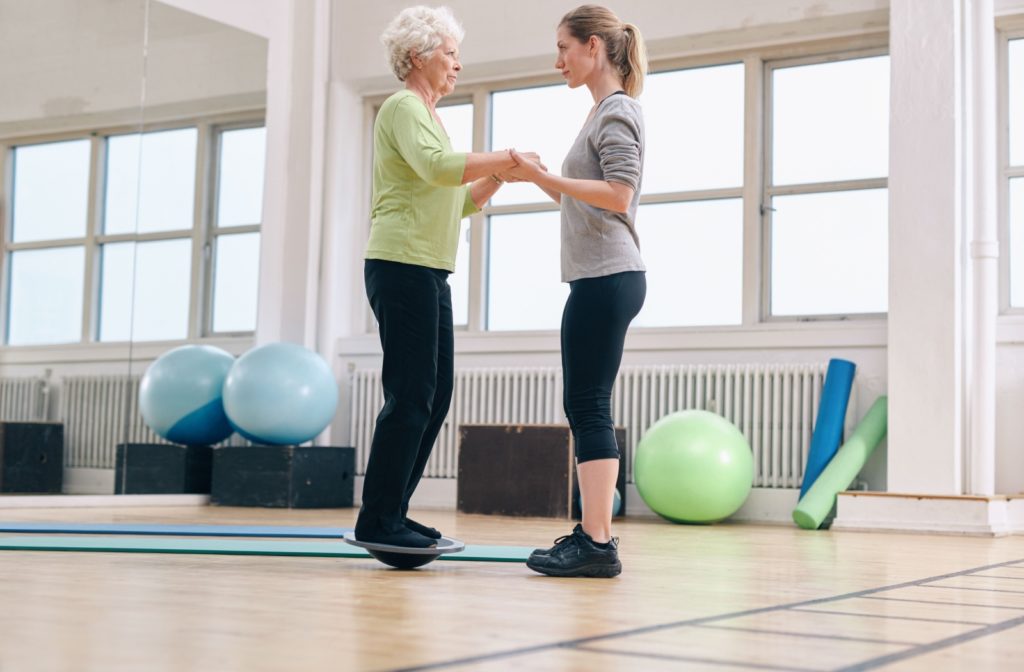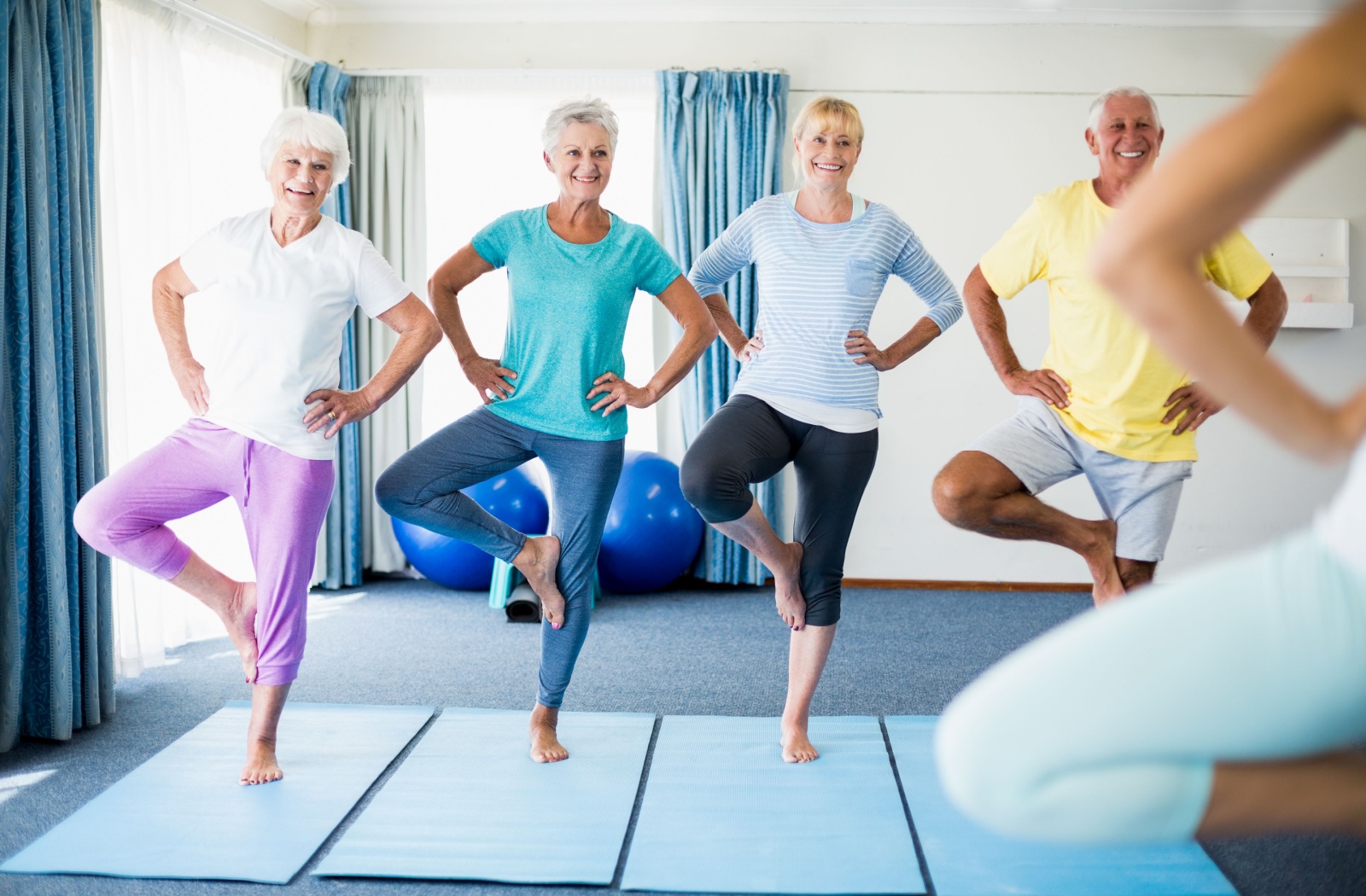Imagine moving confidently and maintaining independence as you age with just a few simple exercises. Balance plays a big role in mobility, stability, and confidence in older adults. Whether it’s navigating crowded gatherings or avoiding slips on rainy sidewalks, improving balance can reduce the risk of falls and is key to a safer and healthier life.
Aging & Its Effects on Balance
Aging impacts the body’s ability to stay balanced, making falls a significant concern for older adults. More than 25% of older adults 65 and over have a fall each year. These falls account for many injuries in older adults, often resulting in hospital visits—and sometimes long-term issues that reduce mobility.
There are several primary systems in the body responsible for balance:
- Vestibular system: This system, located in the inner ear, detects motion and helps regulate spatial orientation. Over time, it begins to decline, leading to dizziness or vertigo.
- Muscular strength: Muscles and joints play a key role in stability. Aging weakens both, reducing their ability to adjust and remain upright.
- Proprioception: This sense allows the body to recognize its position in space. Aging decreases this awareness, making movements less accurate.
Health Conditions That May Worsen Balance
Chronic conditions, such as the following, can worsen balance issues:
- Arthritis: Stiffness in the joints impacts mobility.
- Neuropathy: Nerve damage—often associated with diabetes.
- Parkinson’s disease: Tremors and coordination challenges can significantly affect balance.
Understanding how aging impacts balance is the first step toward addressing the issue proactively.
The Benefits of Balance Exercises for Seniors
Regular balance exercises can combat the above challenges and improve balance and strength in older adults.
Improved Stability & Reduced Risk of Falls
Balance exercises strengthen muscles and improve the body’s response to sudden movements. This makes it easier to recover from slips or trips, thereby reducing the risk of falls.
Enhanced Mobility & Independence
With better balance comes more confidence and ease of movement. Tasks like climbing stairs, grocery shopping, or simply walking in the park become less daunting. This newfound freedom often translates into maintaining an independent lifestyle for longer.
Positive Impact on Cognitive Function
One study found that balance and coordination exercises improve cognitive function. The mental focus and stimulation during these exercises aid memory and spatial recognition.
Simple Balance Exercises Seniors Can Start Today
You don’t need a fancy gym or equipment to get started. Instead, balance exercises can be as simple or dynamic as your comfort level allows.
Static Balance Exercises
These exercises focus on maintaining stillness while standing:
- One-leg stand: Stand near a support (like a chair or wall) and lift one foot off the ground. Hold for 10-30 seconds, then switch legs.
- Tandem standing: Place one foot directly in front of the other, heel to toe, and maintain balance.
Dynamic Balance Exercises
These exercises incorporate movement, making them great for real-life situations:
- Heel-to-toe walk: Take one step forward, placing the heel of one foot directly in front of the toes of the other. Repeat 20 times.
- Chair sit-to-stand: Sit in a sturdy chair and rise to a standing position without using your hands. Repeat 10 times.
Tips to Incorporate Balance Exercises into Your Daily Routine

Starting a new routine can feel overwhelming, but these steps will help make it easy:
- Start slow and safe. If it’s your first time, spend 5-10 minutes daily on simple exercises and work up as you gain confidence. Always keep a sturdy chair or surface nearby for support or seek help from a personal trainer or physical therapist.
- Be consistent. Build a habit by incorporating balance exercises into your daily schedule. For example, try them while waiting for your morning coffee or during commercial breaks while watching TV.
- Mix things up. Combine balance exercises with light stretching and strength training for a well-rounded fitness routine.
Addressing Barriers to Starting Balance Exercises
It’s natural for older adults to feel hesitant about trying something new, especially if they’re worried about injury or embarrassment. Here’s how to overcome these concerns:
- Fear of falling: Begin with exercises where you can hold onto sturdy support, such as a wall or chair. Gradually decrease dependence as your confidence grows.
- Health concerns: Speak with a healthcare professional before starting a routine. They can recommend exercises tailored to specific conditions or limitations.
- Lack of motivation: Caregivers can play a huge role here by joining the exercises or setting small milestones together.
Make Balance a Priority for Quality Living
Maintaining balance isn’t just about preventing falls—it’s about reclaiming confidence, independence, and quality of life as you age. There’s no better time to start than now.
Contact us at All American Assisted Living at Hillsborough to learn more about how we can support loved ones in leading healthy, active, and engaged lives in a community setting.



